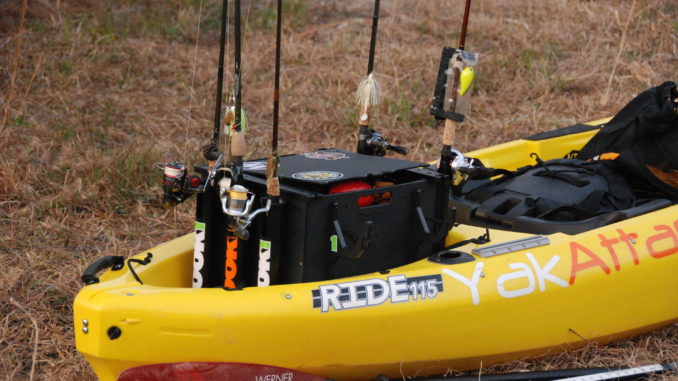
No longer a newbie? Add these to your tricks.
Fishing from a kayak is a work in progress. Everyone gets into the sport at different levels and skill sets, and some progress faster or slower than the rest. Developing skills is essential to advancing both your enjoyment and proficiency in catching fish from a plastic boat.
Here are a few intermediate tips that can help you get more enjoyment, aka catch more fish, from your kayak.
• Get a rudder. If you started with an entry level boat that was not equipped with a rudder, adding one will greatly enhance your maneuverability and tracking. It will allow you to move focus from propelling the boat to positioning the boat.
Rudders for pedal-drive boats are typically steered with a hand tiller, while paddle-propelled boats are steered via cables attached to foot pedals.
Another tremendous advantage of having a rudder on a paddleboat is that in moving water, the current propels the boat while you are allowed to steer with your feet, leaving hands free for fishing.
• Use tracks for rigging. You start out with minimal stuff as a beginner. Once you get the hang of realizing you both want and need your gear within reach, you started rigging the boat to your personal taste and style of fishing. Gear tracks are highly advantageous for storing or mounting your gear where you want it.
Most manufacturers have adopted similar-sized “feet” that slide into gear tracks and secure down to hold the gear in place, whether that be a depth finder, rod holder, or phone cradle. For infinite positioning, many of these items use ball mounts, which secure to the gear track and allow you to position your accessories to custom fit.
• Use smaller tackle boxes. Most beginners quickly transition from taking very little tackle to too much tackle when they get into kayak fishing. One good way is to downsize your tackle storage boxes. The most-common, full-sized tackle storage box is 14×9 inches. The average milk crate or tackle bag stores about four or five of these. Thinking and planning your fishing outing ahead of time will allow you to down size to the medium-sized 10×6 boxes or even to a small 7×4 size.
The smaller box can be left on the deck, under the seat or in a side pouch while being used. Boxes with watertight seals are especially useful when fishing in saltwater where drip and splashes may get into an open box and ruin tackle.
• Learn to cast sidearm. Pre-rigged rods are always a bonus when fishing. Laying pre-rigged rods flat in front on you makes for easy access, but they can also get in the way and subject the rods to breakage. Most anglers opt for storing rods upright in the tank well behind the seat. A milk crate stuffed with PVC tubes of various sizes — or the commercially made equivalent — can hold up to 20 rods, but that negates the prospect of overhead casting.
When fishing from an elevated position or even standing, most anglers become very practiced at making sidearm casts because of the rod storage problem behind them and the tight quarters around them.
• Three-position fishing. It’s time to consider elevating your kayak seat. Does it allow you to sit comfortably in the bottom of the boat as well as adjust to an elevated seated position for better sight fishing? What about standing up? Depending on your balance and the width of your boat, standing up to fish is or soon will be a desired position.
Unfortunately, not a lot of aftermarket rigging is available to assist with making a boat stable enough to stand or accommodate an adjustable set. These are options to consider when moving up to your next fishing kayak.
• Fish inside out. With water temperatures dropping dramatically as fall progresses, it’s time to be fishing where a shallow-draft boat like a kayak shines. Most novice kayakers’ mindsets are to boat position the same way you would in a powerboat. You’ll be amazed at the shallow areas you can fish in a kayak as well as how close a fish will bite oblivious to the boat.
Learn the intermediate skill of fishing choice shallow spots first, then work your way out to deeper water where most of the crowds fish.
• Use good electronics. Anglers used to scoff at the thought of spending nearly as much on electronics for a kayak as the boat itself cost. No more. Good electronics is often the difference between those who consistently catch fish and those who don’t. Make the investment in good electronics, rig the boat properly for the system you are using, and then learn how to interpret what the unit can and is showing you.
• Safety. Finally, intermediate anglers know not to forget their PFD, it may be the form-fitting, inflatable kind rather than the standard foam-filled variety, but they know to wear it. Likewise for filing float plans, carrying appropriate safety gear, and practicing survival skills.
You learned this because you’ve not only experienced how much fun and how satisfying kayak angling is, you’ve also learned how dangerous it can be for the ill prepared.

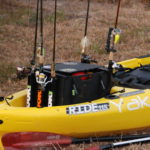
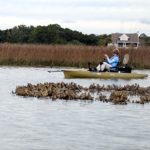
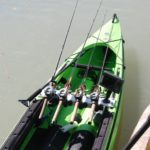

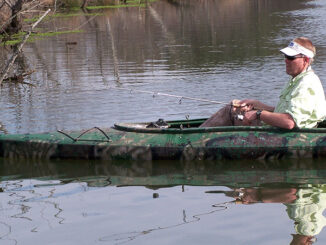
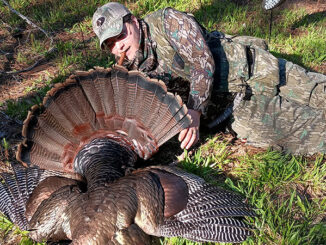

Be the first to comment